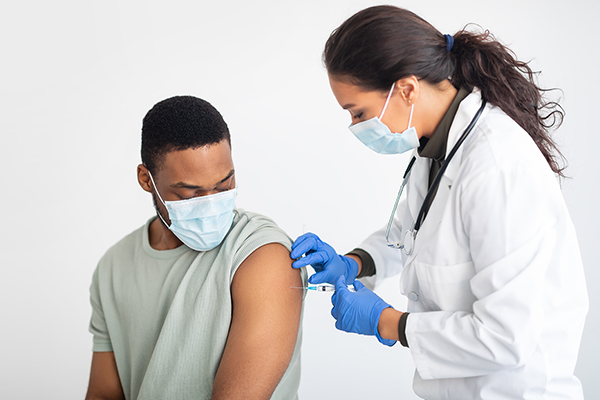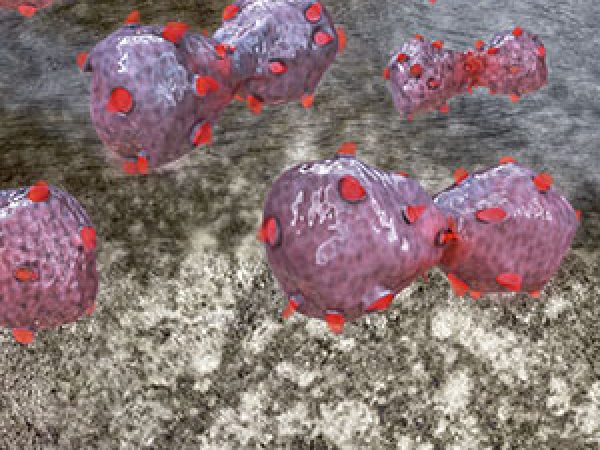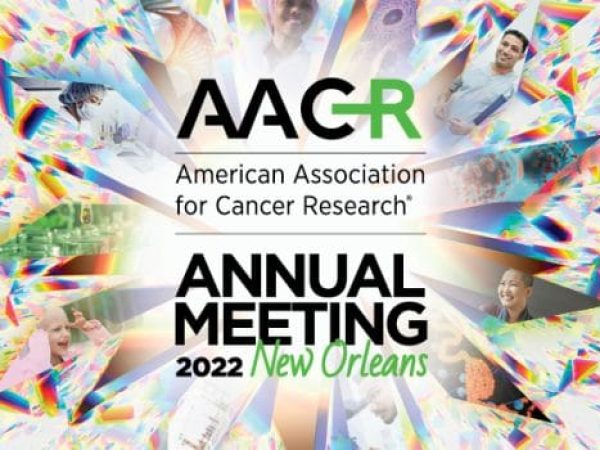AACR Disparities Meeting: Lessons Learned from the COVID-19 Pandemic
While cancer and COVID-19 are, biologically, very different diseases, they have shaken the world in surprisingly similar ways. Nearly everyone knows someone who has battled each illness, both have rallied global research efforts, and both have left lasting physical and financial burdens for patients and their families.
Cancer and COVID-19 also both disproportionately affect people of color and those from under-resourced communities. According to the 2020 Cancer Disparities Progress Report, African Americans are two or more times as likely to die from prostate cancer, gastric cancer, and multiple myeloma than non-Hispanic white individuals and have a 14 percent higher rate of cancer death overall. Similarly, Hispanic Americans are more than 1.5 times as likely to die from gastric and liver cancer than non-Hispanic white Americans.
Continuously updated COVID-19 statistics from the Centers for Disease Control (CDC) mirror these patterns, reporting that Hispanic and Latinx individuals comprise approximately 18 percent of the U.S. population but 26.6 percent of COVID-19 cases (in areas that report COVID-19 data by race and ethnicity). Similarly, the age-adjusted COVID-19 death rate is 12.8 percent higher among Hispanics and 9.7 percent higher among Black Americans than their respective shares of the population.
In spite of the health disparities that COVID-19 has exacerbated, the pandemic has also spurred health equity research and brought communities together in unique ways, improving our understanding of how we might mitigate these disparities. Presenters at the 14th AACR Conference on the Science of Cancer Health Disparities in Racial/Ethnic Minorities and the Medically Underserved, held virtually October 6-8, shared some insights they learned during the pandemic that could help close gaps in cancer care.
Leveraging community and advocacy
The rapid evolution of scientists’ understanding of COVID-19, coupled with constantly changing recommendations, have sparked widespread confusion and fear, including among cancer patients who are more susceptible to complications from the disease. In uncertain times, people turn to trusted sources for comfort and information.
In a special advocacy session titled “Addressing Advocacy at the Bench: COVID-19 Vaccines and Patient Advocates as Trusted Sources of Information,” a panel of patient advocates shared how they connected with their communities during the pandemic to share information and improve distribution of care.
Advocate Desirée Walker, previously profiled in an AACR philanthropy brief, kicked off the session by expressing gratitude that she could fulfill that role for other patients.
“I’m thankful that I have become a trusted source,” Walker said. “Many of the individuals not only in my support group, but in my community, felt comfortable and confident reaching out with their questions and their concerns.”

As vaccines became available, Walker helped organize webinars, collected and shared helpful articles, and invited trustworthy speakers for monthly meetings, among other things. Because she had always brought trustworthy health information to her community, she said, “People knew that I would guide them to the facts.”
For individuals without a built-in network of advocates, especially in areas without robust access to care or information, local communities often become that trusted source. In these cases, it is crucial to promote community-driven efforts to educate and care for patients.
Barbara Segarra-Vazquez, DHSc, patient advocate and dean of the Medical Sciences Campus of the University of Puerto Rico, helped organize a massive vaccination center at the university’s medical sciences campus by leveraging students’ passion for serving their community.
Students and faculty from different programs staffed the clinic, providing services according to their strengths. Pharmacy students prepared the doses, nursing and medical students administered them, and physical therapy students helped elderly patients move through the building.
“One of the things that really made our center unique was being able to integrate students from different disciplines,” Segarra-Vazquez said.
The center also took advantage of the 15-minute observation period following vaccine administration. In the observation room, medical and physical therapy students held educational sessions about side effects, as well as general information about fall prevention and assisted mobility devices.
The strength of this approach, Segarra-Vazquez said, was in the way it brought together the community and made care more accessible to patients. To translate this approach to cancer care, she advocated for partnerships between major medical centers and community clinics.
Bringing care to isolated areas, such as tribal communities, requires additional considerations. Byron Clarke, chief operating officer of the Utah Navajo Health System (UNHS), stressed the importance of meeting patients where they are, both culturally and physically. He expressed that one of the keys to engaging with the community is to show that you care about needs that extend beyond health care.
At the beginning of the pandemic, UNHS organized drive-through food banks throughout the Navajo nation that have delivered, so far, over 400,000 pounds of food and household essentials. As many Navajo families rely on wood for cooking and heating, UNHS also coordinated a massive firewood drive, in which volunteers collected and delivered 3 million pounds of wood to the Navajo nation following a severe windstorm in northern Utah.
“These programs really showed the community that we were reaching out beyond health care,” Clarke said. “It took a lot of our time and effort, but it was really important, because we were building trust.”
It can be especially difficult, however, to build trust with a community that has been historically mistreated by researchers and health care providers. Vivian Carter, PhD, chair of the Psychology and Sociology Department at Tuskegee University, began her talk by acknowledging the “elephant in the room”—the U.S. Public Health Service Syphilis Study at Tuskegee, in which hundreds of Black men were intentionally denied treatment for syphilis so that doctors could study the natural course of the disease.
The study is frequently cited by Black patients as a cause for distrust of medical providers. In attempts to encourage COVID-19 vaccination in the local area, Tuskegee created a pamphlet that addresses its history head-on. The pamphlet includes a statement from Lillie Head, the daughter of a Tuskegee study participant and founder of the Voices for our Fathers Legacy Foundation. Head’s statement concludes with, “Things were different then, and I know that if [my father] were here today, he would want us to do the right thing and get vaccinated for COVID-19.”
In her talk, Carter explained how COVID-19 provided a unique opportunity to speak with various groups about fear, misinformation, and other barriers to receiving health care. She highlighted six key reasons people report not receiving the vaccine—lack of trust in the vaccine, fears about side effects, lack of vaccine access, lack of transportation, inflexible work schedules, and language barriers—that mirror barriers to delivering effective cancer care.
For barriers rooted in fear, Carter explained, hesitancy often stems from misunderstandings or incomplete information, which can be addressed by explaining more about how a treatment was developed and tested. Logistical barriers, however, often reflect systemic obstacles that may require more integrated approaches to overcome. Fortunately, the pandemic has not only pointed out these problems but has also given us suggestions for how to address them.
Access to physical and digital care
Oluwadamilola Fayanju, MD, MPHS, chief of breast surgery at Penn Medicine and an associate professor at the University of Pennsylvania, opened a session titled “Lessons from COVID-19: the future of digital health and reducing cancer disparities” with some striking statistics about areas of the U.S. where minority communities were disproportionately burdened by the disease. A 2020 editorial in the Journal of the American Medical Association, for example, expressed that, in Chicago, African Americans accounted for over 50 percent of the COVID-19 infections and 70 percent of COVID-19 deaths, despite representing only around 30 percent of the city’s population.
“Initially referred to as the ‘great equalizer,’ in actuality, COVID-19 proved to be the ‘great revealer,’” Fayanju said.
She went on to explain that disparities extend beyond the disease itself and to the broader ways health care changed during the pandemic. The expansion of telemedicine services, for example, revealed that not everyone has equal access to technology.
Around one quarter of Americans may not have sufficient internet access or technology literacy to attend a videoconference appointment with a health care provider, Fayanju said. Further, groups that already face discrimination in health care settings, such as older adults and racial and ethnic minorities, are less likely to have sufficient access.
“We must seek out opportunity in the midst of this crisis, taking advantage of technologies such as telemedicine, but we must not fall into old traps, through which we potentially exacerbate disparities by providing innovation to a select few,” said Fayanju. She suggested that health care practices could help by relying less on live video, prioritizing the use of interpreters and text-based communication when necessary, and partnering with community organizations to increase access to computers and internet.
However, she added, the best way to ensure equity is to pay attention to “who is at the table when these decisions are being made.” Prioritizing the patient’s perspective upfront, when new technologies are being tested, is key to avoiding designs that further disparities.
Jorge Rodriguez, MD, an internal medicine physician at Brigham and Women’s Hospital, elaborated on this idea in a subsequent talk. “Current digital tools have not engaged marginalized populations in the development process and have only considered their needs as an afterthought,” he said.
Rodriguez suggested specific strategies for improvement at both the provider level and the public policy level. For providers developing and implementing digital tools, Rodriguez recommended testing new technologies on people of various ages, races, ethnicities, and socioeconomic status, to ensure interfaces accommodate as many people as possible. Further, they should engage patients and families at regular intervals to identify areas where they may be struggling. Finally, practices should consider hiring digital health navigators—individuals designated to help patients interact with digital systems and ensure accessibility of digital tools.
These measures may prove useless, however, without broader changes to technology infrastructure. Digital redlining—discrimination from internet service providers in terms of the quality, content, or price of services provided to different areas—has contributed to the lack of health care access in marginalized communities, Rodriguez said. Policies that prevent digital redlining, provide subsidies for equipment and internet access, protect internet-enabled community spaces, and simplify insurance reimbursement for telemedicine services could all help push the needle forward.
“Digital equity is a social determinant of health,” Rodriguez concluded. “We must ensure that we evaluate the impact of these tools on our ultimate goal of health equity.”
When telemedicine is employed with equity in mind, it can also have positive impacts on cancer care, explained Kathie-Ann Joseph, MD, MPH, a professor of surgery and population health in the NYU Grossman School of Medicine. When her hospital experienced a 4,345 percent increase in non-urgent telemedicine visits between March and April of 2020, Joseph wanted to see whether this shift in the care landscape could be used to close a known gap in cancer treatment.
Black and Hispanic breast cancer patients, she explained, are less likely than white patients to have conversations with their providers about genetic testing, even though they undergo testing at similar rates when properly referred. Joseph and colleagues examined participation in a virtual genetic testing program at Bellevue Hospital during the year 2020 and found that these disparities were mitigated—46 percent of patients in the program were non-White.
As compared with genetic testing appointments in 2019, which were all in person, appointments in 2020 had a significantly lower no-show rate—13.47 percent compared with 36.88 percent. Further, the vast majority of patients surveyed said they were ‘satisfied’ or ‘very satisfied’ with their experience. After restrictions were lifted, many patients said they’d still rather be seen in the clinic than virtually, however, suggesting that the way telehealth is provided can continue to be improved.
“We’re assuming that telehealth is here to stay,” Joseph said. “What impact it will have on the spectrum of cancer care remains to be seen.”



